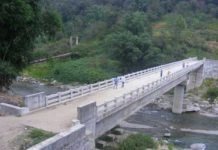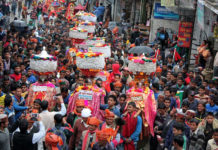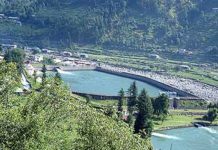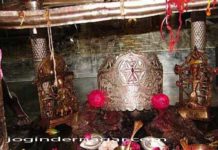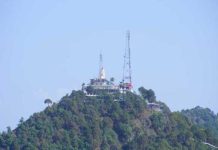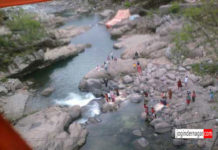Jwalamukhi Devi Temple
Jwalamukhi is a famous temple devoted to goddess Jwalamukhi, the deity of flaming mouth. Raja Bhumi Chand Katoch of Kangra, a great devotee of goddess Durga, dreamt of the sacred place and the Raja set people to find out the whereabouts of the site. The site was traced and the Raja built a temple at that location. The building is modern with a gilt dome and pinnacles, and possesses a beautiful folding door of silver plates. Under the gaze of the Dhauladhar range and set amidst the undulating hills that character sub-Himalayan Himachal Sati’s tongue is believed to have fallen at Jwalamukhi and the goddess is manifest as tiny flames that burn a flawless blue through fissures in the age old rock.

On the backside of the temple water runs along a water-course which takes off from a spring high above. Some say this canal was constructed by Emperor Akbar to try to quench the flames. The attempt having proved abortive, he became a devotee of the Goddess. The song popularly sung in praise of the Goddess describes how the Mughal Emperor came barefooted and placed a crown of gold before the Goddess as offering. That crown is still preserved and it is said, it was turned into copper as soon as the Emperor looked back in pride and thought of costly present he had made.
The interior of temple consists of a square pit about three feet deep with a pathway all round. In the middle, the rock is slightly hollowed out about the principal fissure and on applying a light the gas bursts into flames. The gas escapes at several other points from the crevices of the walls of the pit. There is no idol of any kind, the flaming Fissure being considered as the fiery mouth of Goddess. There is the Gorakh Dibbi, Chaturbhuj Temple and a host of other smaller shrine at Jawalamukhi town.
Legends
It is believed that the Pandavas later renovated the temple. The folk song that “Panjan Panjan Pandavan Tera Bhawan Banaya” bears testimony to this belief. Raja Bhumi Chand, the progenitor of the ruling Katoch family of Kangra, first built the temple. Jawalamukhi has since times immemorial turned out to be a great pilgrimage centre. The Mughal Emperor Akbar once tried to extinguish the flames by covering them with an iron disk and even channelizing water to them. But the flames blasted all these efforts. Akbar then presented a golden parasol at the shrine. However, his cynicism at the power of devi caused the gold to debase into another metal. His belief in the deity was all the more strengthened after this incident. Thousands of pilgrims visit the shrine round the year to satisfy their spiritual urge.
Climate
During summer, the climate is mild and light woollens/cottons are recommended. In winter, the temperature can drop to freezing point when heavy woollens are required.
How To Reach
By Air
Closest Airport is at Gaggal, 50km away. Chandigarh airport is at a distance of around 200 km.
By Rail
The nearest Narrow gauge is at Ranital, 20 km away. Also Nearest Broad Gauge Railway Station is at Pathankot, More than 100km away
By Road
The temple is also well connected by road. State transport buses from cities of Punjab and Haryana are available. Taxis are also there to take you to the Jwalamukhi temple.









